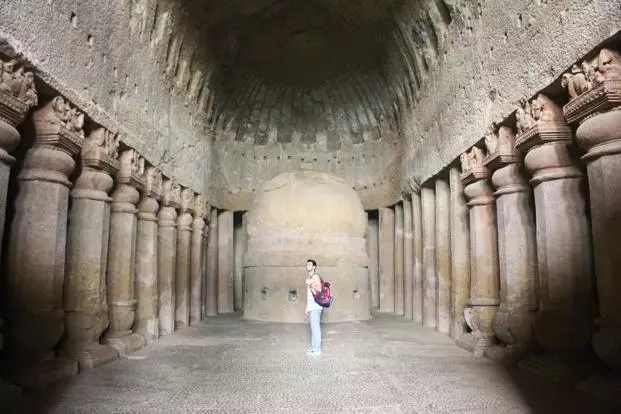If you’ve ever thought of Mumbai as just a buzzing metropolis with beaches and Bollywood, you’re in for a surprise. Just a stone’s throw away from the city’s hustle, tucked away inside the lush green Sanjay Gandhi National Park, are the Kanheri Caves, a hidden treasure rich in history, spirituality, and jaw-dropping architecture. Ready to step back and explore a place that’s been quietly fascinating visitors for over 2,000 years?
How Many Temples Are There in Kanheri Caves?
So, let’s start with a question that I’m sure is on your mind — how many temples are there in Kanheri Caves? Well, to put it simply, there are a lot! The caves are home to over 100 caves, and many of these were used for meditation and worship by Buddhist monks.
Here’s what’s cool: the caves contain not just temples but an entire monastic complex. The main highlights include:
Chaityas (Prayer Halls):
These are large, spacious halls that you can’t help but feel awe-struck by. The most famous one is Cave 3, which has this massive stupa (a dome-shaped structure symbolizing Buddha) sitting right at the center, surrounded by beautifully carved pillars. It’s like stepping into a piece of history, and it’ll hit you with the sheer scale of it all.
Viharas (Monastic Cells):
Now, the Viharas are the more personal side of the caves. These were small living quarters for the monks, where they ate, meditated, and lived their simple, spiritual lives. You’ll find intricate Buddha sculptures in many of them — each so serene and peaceful that you can’t help but feel calm.

Temples and Stupas:
There are temples, each carved with incredible detail. Cave 34, for example, houses a temple with a massive Buddha statue, sitting in meditation like he’s seen centuries go by. It’s mesmerizing.
So, to answer your question, there’s no one temple but a collection of temples, stupas, and meditation halls, each telling a different part of the story of Buddhism and the monks who lived here. It’s like a spiritual village frozen in time.
A Little History of Kanheri Caves: Where the Past Meets Peace
Okay, let’s go back in time for a second. The Kanheri Caves have been around for over 2,000 years, and trust me, their story is just as fascinating as the caves themselves. Ancient monks carved out these spaces from the hard basalt rock, starting in the 1st Century BCE. Can you imagine the sheer effort that must have gone into it? It’s like they were sculpting their way to enlightenment.
The Early Days:
Monks Seeking Solitude (1st Century BCE – 6th Century CE)The caves were initially carved out by Buddhist monks who came here to meditate, pray, and study. Think about it — there was no rush, no distraction, just the sound of your thoughts and the rustling of trees around you. And honestly, who wouldn’t want that level of peace? These caves were initially part of the Hinayana school of Buddhism, but over time, as Mahayana Buddhism grew in popularity, the architecture and sculptures became more elaborate.
The location was strategic, right along an ancient trade route connecting Mumbai to the rest of India. Thus, it was both a spiritual hub and a meeting point for merchants. Not only did the monks meditate here, but the caves also became places for cultural exchange.
Kanheri’s Peak:
A Spiritual Haven (4th – 6th Century CE)By the 4th Century, the Kanheri Caves were at their zenith. Picture hundreds of monks living and studying here, surrounded by sacred symbols of the Buddha and the peaceful ambiance that we can only dream of in today’s busy world. This was when the caves were expanded, with new shrines, stupas, and elaborate carvings that spoke volumes about the artistic skills of the time.
And here’s a fun fact:
did you know that Kanheri was not just about meditation? Some of the caves also have remnants of vibrant frescoes and sculptures depicting the life of Buddha, his teachings, and even the Bodhisattvas (enlightened beings) who helped spread the Buddhist message.
The Quiet Decline:
Rediscovery in the 19th Century Like many ancient sites, Kanheri eventually declined, largely because kings and patrons’ attention shifted away from Buddhism during the rise of Hinduism. By the 7th Century, the caves were abandoned and lost to time.
But don’t worry! The caves were rediscovered in the 19th Century, thanks to some explorers and historians who saw the potential in these mystical ruins. Over the years, they’ve been restored and preserved, allowing us to marvel at their beauty today. Can you imagine stumbling upon this place, half-buried in nature and history?
What Makes Kanheri Caves So Special?
Now, let’s get to the good stuff: what makes the Kanheri Caves such a unique experience? It’s not just about seeing old temples; it’s about feeling the weight of history, spirituality, and art around you. Here are some of the highlights of the cave that you will visit on your Mumbai tours:
The Architecture:
The caves are rock-cut, meaning the monks and artisans carved them directly into the volcanic basalt rock. It’s mind-blowing to think about the labor that went into creating these perfectly symmetrical halls, stupas, and cells. You’ll find yourself tracing the carved patterns with your eyes, and it’s like each groove tells a different story. Every detail speaks of patience and precision.
The Buddha Statues:
Walking around the caves, you’ll encounter the most serene, peaceful Buddha statues—all sitting in the lotus position with their eyes half-closed in meditation. It’s an emotional experience; you’ll find yourself slowing down and taking a deep breath, just like the monks must have done all those centuries ago.
The Silence and Peace:
This is one thing that always surprises me. Though near the city, the caves have this beautiful silence to them. Surrounded by trees and the occasional bird chirping, it’s the perfect place for some quiet reflection. Even if you’re not the meditative type, you’ll find that this is a place that just slows you down.
Views for Days:
Let’s talk about the view. From the top of the hill, where the caves sit, you can see the sprawling Sanjay Gandhi National Park. On a clear day, the view is breathtaking, with green hills stretching as far as the eye can see and Mumbai’s concrete jungle far off in the distance.
How to Visit Kanheri Caves: Your Guide to a Perfect Day Out
Excited yet? Here’s everything you need to know to plan your trip to the Kanheri Caves:
Location:
The Kanheri Caves are inside Sanjay Gandhi National Park in Borivali, a northern suburb of Mumbai. They are about a 30-minute drive from the city, and the nearest train station is Borivali Station.
Entry Fee:
Entry to the caves is affordable, and if you’re into photography, there’s a small fee for that as well. It’s worth it for the memories you’ll take away.
Timings:
The caves are open from 9 AM to 5 PM, so you can easily plan a half-day trip. If you want to avoid crowds, I suggest heading out early. The cool morning breeze and peaceful vibes are unmatched.
Best Time to Visit:
The best tim e to visit is between November and February when the weather is cooler, and the views are stunning.
Guides and Tours:
You can combine your visit with our Dharavi Slum Tour to get a real feel of the contrast between ancient spirituality and modern-day life.
If you’re looking for a break from Mumbai’s fast pace, the Kanheri Caves included in our Mumbai Tour are the perfect escape. Whether you’re a history buff, a nature lover, or just someone who wants to soak in peace and serenity, this place has something magical about it. We promise that the moment you step inside these ancient caves, you’ll be transported into a world where time slows down, and all you have to do is take a deep breath and enjoy the beauty surrounding you. So, next time you’re in Mumbai, don’t just stick to the usual tourist spots; visit the Kanheri Caves and let yourself be amazed.







